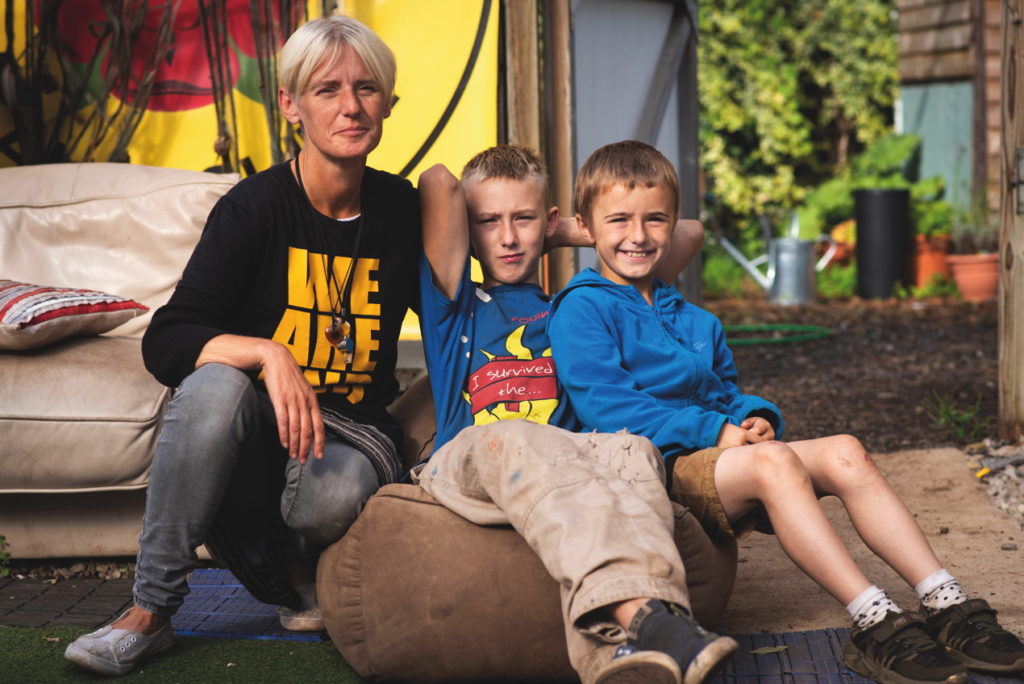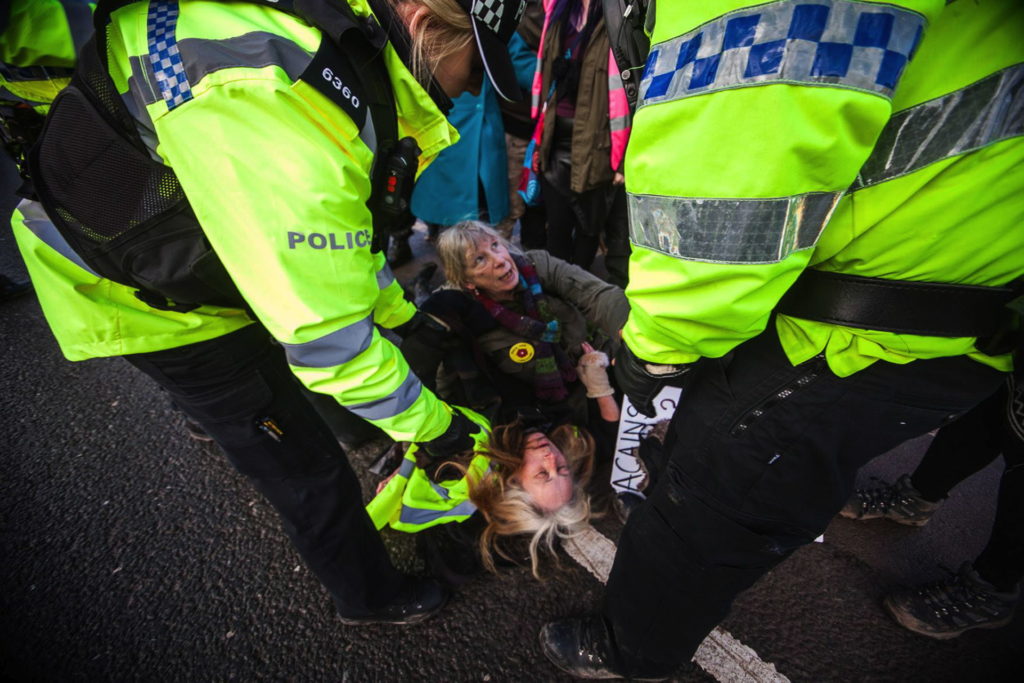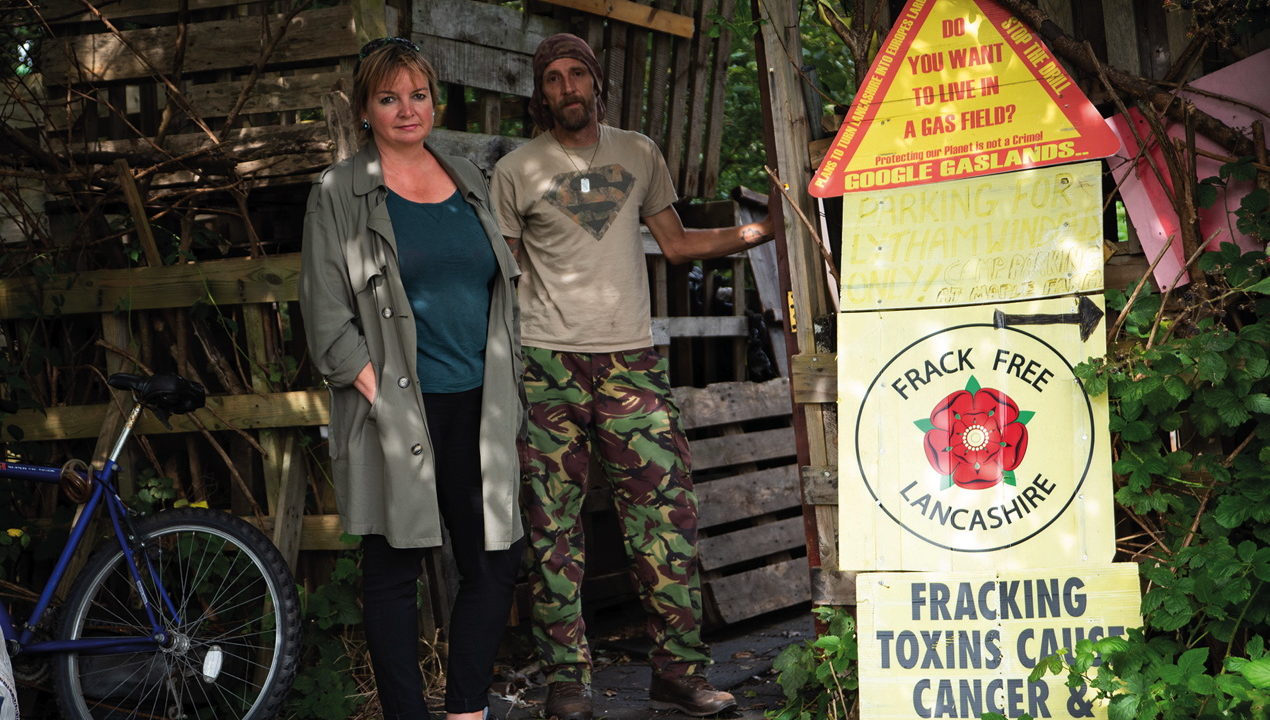‘A win for people power’
Campaigners are hailing the government’s moratorium on fracking as a victory but with energy firms hoping to overturn the suspension, they won’t be dropping their guard
Anti-fracking activists were doubly vindicated last week when their claims that the extraction of shale gas is unsafe, and that the policing operation around it has been heavy handed, were confirmed by the government, data analysis and academic research.
Energy secretary Andrea Leadsom’s announcement on 2 November that fracking would be halted in the UK with immediate effect came on the heels of a damning academic study that revealed violent, intimidating and discriminatory policing towards activists protesting against it.
The Conservative government’s U-turn has been described as a watershed moment for anti-fracking activists, who first mobilised in 2011 following a 2.3 magnitude (ML) earth tremor caused by Cuadrilla’s experimental fracking at Preese Hall, near Blackpool.
Cuadrilla’s largest shareholder, AJ Lucas, did not acknowledge it as the end of fracking
Claire Stephenson from Frack Free Lancashire said: “The end of gratuitous government support for fracking is not a moment too soon.
“Residents are delighted that the fracking industry will no longer receive unlimited favours and free passes from a previously pro-fracking government.”
Steve Mason from national campaign group Frack Free United added: “We look forward to seeing the money that would have been spent on pushing fracking onto communities being used to support green energy, the police and the NHS.”
In her statement Leadsom said that while the government still believes it “critical” that the UK has good access to domestic natural gas, it will only support the development of the industry as long as it is “safe and sustainable – both for the environment and local people”.
The government reviewed the Oil and Gas Authority’s (OGA) analysis of data from the first well at Cuadrilla’s flagship site on Preston New Road (PNR) near Blackpool. It was partially fracked 12 months ago, causing 56 earth tremors, the largest measuring 1.5ML. Ministers concluded they could not be confident that fracking would not “cause unacceptable levels of seismicity” and confirmed a “presumption against” any further consent to frack.
Leadsom added: “This position, an effective moratorium, will be maintained until compelling new evidence is provided which addresses the concerns around the prediction and management of induced seismicity.”
Critics, including Jeremy Corbyn – who has consistently vowed to ban fracking under a Labour government – have suggested the timing of the moratorium, which is not an outright ban, is a tactical move by the Conservatives during a general election campaign. Boris Johnson previously called the process of extracting gas from shale rock thousands of feet below the surface, by injecting water, sand and chemicals at high pressure, “glorious news for humanity” and urged the industry to “leave no stone unfracked”. But most of the stones were concentrated north of Derbyshire, leading to accusations of a “northern sacrifice zone”.
A previous moratorium, the result of the Preese Hall earthquake, was imposed in 2011 and lifted a year later.
“We’ve been here before,” said Debra Whiteside, from Longridge, near Preston, joined by her two sons at PNR gate camp to document Cuadrilla’s activities. “The government forced fracking on us after local government said no. Trust is not there for me.”
She does not believe this is the end of fracking in the UK. Nor does trade body United Kingdom Oil and Gas (UKOOG), which responded to the government announcement by saying it was determined to frack.
“We are fully committed to working closely with the Oil and Gas Authority and other relevant regulators to demonstrate that we can operate safely and environmentally responsibly,” said chief executive Ken Cronin.
“Given the size of the prize at stake – the significantly lower carbon footprint of domestic gas compared to imports and the significant investment the industry and the government have already made – we believe this is the right approach.”

In a report published on 23 October, the National Audit Office said the cost of fracking to the taxpayer was at least £32.7 million since 2011 – including £13.4 million spent by three police forces on managing protests, £11.8 million of which was policing PNR. The cost of appeals, judicial reviews, and the time and expenses of public servants was not factored in.
Cuadrilla’s largest shareholder, Australian energy firm AJ Lucas, did not acknowledge the moratorium as the end of fracking in the UK either and said it would continue to lend the company its full support, while “recognising that there will be unavoidable delays in operations”. It said it would continue to provide funding, “albeit significantly reduced”. Shares in the company closed down 23 per cent last Monday, 4 November.
Nor did Cuadrilla appear defeated. In a statement the Bamber Bridge-based energy firm said it will begin work on providing the “compelling new evidence” the government has called for.
It said: “We will now review interim reports in detail and continue to work constructively with the OGA to provide further detailed data (including data from the PNR2 well) to address concerns so that the moratorium can be lifted and the highly prospective Bowland gas resource further appraised and developed.”
Cuadrilla fracked PNR2, its second well, this summer with a larger seismic impact – 134 earth tremors, the largest measuring 2.9ML and causing damage to local property. But the government did not use data from that well when making its decision.
Cuadrilla insisted that the gas extracted is of “extremely high quality” and claimed it could “flow directly into the UK’s extensive gas network without requiring additional treatment or processing, other than water separation”.
Since extraction was only exploratory Cuadrilla has been busy burning off that “high-quality” but nevertheless wasted gas in recent weeks, using flare stacks – which release methane and other greenhouse gases into the atmosphere. The firm has also been directly venting unburnt gas into the atmosphere through nitrogen lifting – a technique used to remove liquids in the well that prevented gas flowing to the surface. This is a practice the Environment Agency (EA) prohibited until last month, when it made the latest in a string of changes to the firm’s environmental permit to allow it to keep heading deeper into uncharted territory.
Ultimately, it is the tangible threat of earthquakes rather than the climate impact of fracking that prompted the government U-turn. Activists at PNR remain sceptical and vigilant.
“It’s a time for cautious celebration and taking stock of what we have achieved because it has been a rollercoaster ride for the last few years and we are exhausted,” said Miranda Cox, who has campaigned daily for over two years at PNR. “While we’re optimistic that this is the end there are potentially a few areas we need to keep an eye on. We don’t want to disband while Cuadrilla is still here, and those flare stacks are still standing. We need to remain a presence.”
One such area is acidisation, which could challenge the reach of the moratorium after a public inquiry into oil extraction plans near Scunthorpe concluded last week.
The unconventional form of exploration, where acids are used to dissolve stone underground to allow fossil fuels to flow to the surface, is planned to take place at the site run by Egdon Resources in Wressle.
On the first day of the inquiry, fracking news website Drill or Drop reported that the site’s environmental permit refers to hydraulic fracturing and the proposed operation will require a hydraulic fracture plan. The process was previously called “acid fracking” until the government redefined fracking in the 2015 Infrastructure Act. Egdon insists its process isn’t fracking. Opponents argue it is.
The activist community wants the moratorium extended to include acidisation – which it calls “fracking by stealth”. Ths inspector’s decision is expected after the general election.
Protesters at PNR told Big Issue North they would go and lend support to battles against other forms of unconventional oil and gas extraction, as well as wider climate change campaigns such as against HS2, if Cuadrilla does abandon PNR.
Cox, a former Kirkham councillor who made the transition to full-time protest after joining the PNR campaign, credits the makeshift camps of activists who have come to help local people in Lancashire. She says this victory wouldn’t have happened without them.
“This is a win. It’s a significant thing for people power and resistance.”

Violation and fear are the defining feelings of women protesting against the fracking industry, according to a new report from Liverpool John Moores University.
Academics carried out the study at sites across the country, including Preston New Road, in 2016-2019 and found a pattern of gender discrimination by police, which echoes the experiences of women at protests at Barton Moss in Salford, in 2013-2014.
“[Restraint] techniques involve a much closer form of bodily contact between women protesters and male police officers, which, according to the testimonies we have collected, includes the use of groping and tactics such as the pulling of clothing to reveal women’s breasts. These tactics have been understood by protesters as an exercise of power,” academics said in the report.
“I’ve seen officers deliberately target younger women who are often quite slightly built. I’ve seen officers be very, very physical with them… Some of the younger women are taken upside down,” said one 45-year-old protester.
She said she had seen police restraining protesters deliberately lift their tops so their breasts and bras were exposed, and pull them by their hair.
The report adds that disabled and elderly protesters have also been subjected to violent policing but heavy-handed tactics appeared across the board.
“Protester testimonies report police officers shoving, pushing, dragging and physically restraining, moving and containing protesters. In some cases – most notably at Preston New Road – this type of violence was said to take place on a daily basis,” the report said. “Some of these violent incidents have led to protesters reporting physical injuries, including severe bruising, broken bones and chronic pain.”
In addition to physical violence, the report cites the use of inflammatory and antagonistic behaviour, including verbal harassment and goading by police.
“A key theme emerging from these experiences is that the use of violent conduct coupled with the inconsistent nature of how the protests would be managed on a daily basis resulted in a series of brutalising effects,” it said. “These include trauma resulting from fear, pain, distrust and anger, all instilled by the continuum of violence reported at anti-fracking protests.”
The report says the violent policing contrasted with the “overwhelmingly peaceful” nature of the protests and, coupled with the misuse of arrest and bail powers, is seen as part of a general attempt to criminalise protest.
“The police response to anti-fracking since 2016 has been disproportionate and has had the effect of undermining the right to protest,” the report stated.
The cost of policing the fracking operation stands at £13.4 million, according to a report from the National Audit Office last month. The government has contributed £5.7 million towards it, with the remainder coming off local policing budgets.
The LJMU study also found that police encouraged private companies to use civil injunctions against protesters, with a “chilling effect on the right to protest”.
The academics – from Liverpool John Moores University, the University of York and the University of London – have given five recommendations to police, including respecting the fundamental right to protest.
Responding to the report, the National Police Chiefs’ Council lead on shale, gas and oil exploration, DCC Terry Woods, said: “The police service always welcome feedback concerning policing operations and we will always consider carefully issues raised with us.
“However, I feel there has been a missed opportunity to make this a more meaningful piece of research by not consulting the police for their side of the story, and limiting the research to the opinions of a small number of people with what appears to be a similar point of view.
“Nevertheless, the police service will continue to work tirelessly to engage with all interested parties and to balance the rights of all those protesting.”
